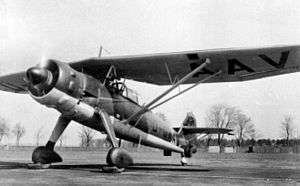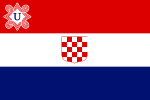Henschel Hs 126
| Henschel Hs 126 | |
|---|---|
 | |
| Role | Reconnaissance |
| Manufacturer | Henschel, AGO |
| First flight | August 1936 |
| Introduction | 1937 |
| Retired | 1942 |
| Primary users | Luftwaffe Bulgaria Greece Croatia Spain |
| Produced | 1937–1941 |
|
| |
The Henschel Hs 126 was a German two-seat reconnaissance and observation aircraft of World War II that was derived from the Henschel Hs 122. The pilot was seated in a protected cockpit under the parasol wing and the gunner in an open rear cockpit. The prototype aircraft frame was that of a Hs 122A fitted with a Junkers engine. The Hs 126 was well received for its good short takeoff and low-speed characteristics which were needed at the time. It was put into service for a few years, but was soon superseded by the general-purpose, STOL Fieseler Fi 156 Storch and the medium-range Focke-Wulf Fw 189 "flying eye".
Development
The first prototype was not entirely up to Luftwaffe standards; it was followed by two more development planes equipped with different engines. Following the third prototype, ten pre-production planes were built in 1937. The Hs 126 entered service in 1938 after operational evaluation with the Legion Condor contingent to the Spanish Civil War.
Operational history
By the time the Hs 126 A-1 joined the Luftwaffe, the re-equipping of reconnaissance formations was already well advanced, and by the start of World War II in September 1939, Germany already had several good short range observation and long range recon aircraft. Late in the war, it was used in glider tug and night ground attack roles, but production of the Hs 126 ended in 1941 and the type was retired from the front line in 1942.[1]
On 12 September 1943 Henschel 126s were used to tow 10 DFS 230 attack gliders from Pratica Di Mare airfield near Rome to the Gran Sasso on a raid to rescue Benito Mussolini. Mussolini had been imprisoned there after being deposed by the Grand Council of Fascism, followed by a decree from the King of Italy. The Henschel was a smaller tow plane compared the usual Junkers Ju 52 three-engine tow plane and struggled to gain altitude to clear the mountains on the way. This led to confusion when the lead Kette of three gliders turned to gain altitude allowing Otto Skorzeny's group of three gliders to assume the lead.[2]
Operators
 Independent State of Croatia
Independent State of Croatia- Croatian Air Force
 Estonia
Estonia- Estonian Air Force
.svg.png) Nazi Germany
Nazi Germany- Luftwaffe
.svg.png) Kingdom of Greece
Kingdom of Greece- Royal Hellenic Air Force
.svg.png) Spain
Spain- Spanish Air Force
Specifications (Hs 126 B-1)

General characteristics
- Crew: Two (pilot and observer/gunner)
- Length: 10.9 m (35 ft 7 in)
- Wingspan: 14.5 m (47 ft 7 in)
- Height: 3.8 m (12 ft 4 in)
- Wing area: 31.6 m² (340 ft²)
- Empty weight: 2,030 kg (4,480 lb)
- Loaded weight: 3,090 kg (6,820 lb)
- Powerplant: 1× Bramo 323 9-cylinder radial engine, 625 kW (850 PS)
Performance
- Maximum speed: 356 km/h at 3,000 m (221 mph at 9,850 ft)
- Range: 998 km (620 mi)
- Service ceiling: 8,530 m (28,000 ft)
- Rate of climb: 550 m/min (1,800 ft/min)
- Wing loading: 97.8 kg/m² (20.1 lb/ft²)
- Power/mass: 0.21 kW/kg (0.13 hp/lb)
Armament
- 1 × forward-firing 7.92 mm (.312 in) MG 17 machine gun
- 1 × flexible 7.92 mm (.312 in) MG 15 machine gun in the observer/gunner
- Up to 150 kg (330 lb) of bombs
See also
- Aircraft of comparable role, configuration and era
- Related lists
- List of aircraft of World War II
- List of World War II military aircraft of Germany
- List of military aircraft of Germany
References
| Wikimedia Commons has media related to Henschel Hs 126. |
Notes
- ↑ Simkin, John. "Henschel Hs 126B." Spartacus Educational. Retrieved: 12 September 2012.
- ↑ Raid: Rescuing Mussolini, Robert Forczyk- Osprey Publishing, April 2010; 64 pages; ISBN 9781846034626
Bibliography
- Green, William. Warplanes of the Third Reich. London: Macdonald and Jane's Publishers Ltd., 1970 (fourth impression 1979). ISBN 0-356-02382-6.
- Luranc, Zbigniew. Henschel Hs 126 - Skrzydła w Miniaturze (in Polish). Gdańsk, Poland: Wydawnictwo Avia-Press, 1995. ISBN 83-902964-0-3.
- Nowarra, Heinz J. Nahaufklärer, 1910-1945: Die Augen des Heeres (in German). Stuttgart, Germany: Motorbuch Verlag, 1981. ISBN 3-87943-808-0.
- Pęczkowski, Robert and Robert Panek. Henschel Hs 126. Sandomierz, Poland/Redbourn, UK: Mushroom Model Publications, 2008. ISBN 83-89450-40-2.
- Smith, J. Richard and Anthony Kay. German Aircraft of the Second World War. London: Putnam & Company Ltd., 1972 (third impression 1978). ISBN 0-370-00024-2.
- Wood, Tony and Bill Gunston. Hitler's Luftwaffe: A Pictorial History and Technical Encyclopedia of Hitler's Air Power in World War II. London: Salamander Books Ltd., 1977. ISBN 0-86101-005-1.